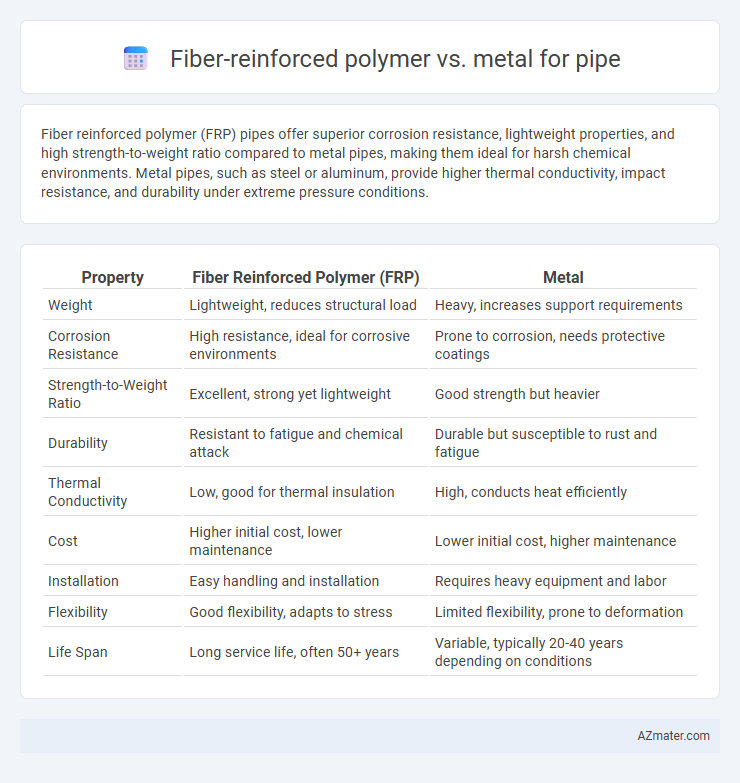Fiber reinforced polymer (FRP) pipes offer superior corrosion resistance, lightweight properties, and high strength-to-weight ratio compared to metal pipes, making them ideal for harsh chemical environments. Metal pipes, such as steel or aluminum, provide higher thermal conductivity, impact resistance, and durability under extreme pressure conditions.
Table of Comparison
| Property | Fiber Reinforced Polymer (FRP) | Metal |
|---|---|---|
| Weight | Lightweight, reduces structural load | Heavy, increases support requirements |
| Corrosion Resistance | High resistance, ideal for corrosive environments | Prone to corrosion, needs protective coatings |
| Strength-to-Weight Ratio | Excellent, strong yet lightweight | Good strength but heavier |
| Durability | Resistant to fatigue and chemical attack | Durable but susceptible to rust and fatigue |
| Thermal Conductivity | Low, good for thermal insulation | High, conducts heat efficiently |
| Cost | Higher initial cost, lower maintenance | Lower initial cost, higher maintenance |
| Installation | Easy handling and installation | Requires heavy equipment and labor |
| Flexibility | Good flexibility, adapts to stress | Limited flexibility, prone to deformation |
| Life Span | Long service life, often 50+ years | Variable, typically 20-40 years depending on conditions |
Introduction to Pipe Materials: FRP vs Metal
Fiber reinforced polymer (FRP) pipes offer superior corrosion resistance and lightweight properties compared to traditional metal pipes such as steel or ductile iron. Metals provide high tensile strength and thermal conductivity but are prone to rust and require frequent maintenance in harsh environments. FRP materials combine strength with chemical resistance, making them ideal for applications in aggressive industrial settings and reducing lifecycle costs relative to metal piping systems.
Material Composition and Properties
Fiber reinforced polymer (FRP) pipes consist of a polymer matrix reinforced with fibers such as glass, carbon, or aramid, offering high strength-to-weight ratios and excellent corrosion resistance. Metal pipes, typically made from steel, aluminum, or copper, provide superior tensile strength and thermal conductivity but are prone to corrosion and heavier weight. FRP pipes exhibit enhanced chemical resistance and flexibility, making them ideal for corrosive environments, whereas metal pipes excel in high-temperature and high-pressure applications.
Weight and Structural Efficiency
Fiber reinforced polymer (FRP) pipes exhibit significantly lower weight compared to metal pipes, often reducing overall system weight by up to 70%, which enhances ease of handling and lowers installation costs. The high strength-to-weight ratio of FRP underscores superior structural efficiency, providing excellent corrosion resistance and fatigue performance while maintaining mechanical integrity. Metals such as steel offer higher absolute strength but suffer from increased weight and susceptibility to corrosion, impacting long-term durability and maintenance requirements.
Corrosion Resistance in Different Environments
Fiber reinforced polymer (FRP) pipes exhibit superior corrosion resistance compared to metal pipes, especially in chemically aggressive environments such as seawater, acidic soils, and industrial effluents. Unlike metals, FRP materials are inherently immune to rust and chemical degradation, reducing maintenance costs and extending service life in harsh conditions. Metal pipes, including steel and iron, require protective coatings or cathodic protection to prevent corrosion, which can fail over time and lead to significant infrastructure damage.
Installation Process and Costs
Fiber reinforced polymer (FRP) pipes offer significantly easier installation compared to metal pipes due to their lighter weight, which reduces labor and equipment expenses. The corrosion resistance of FRP eliminates the need for extensive protective coatings, lowering maintenance and lifecycle costs. Conversely, metal pipes often require heavy machinery for handling and additional anti-corrosion treatments, increasing both initial installation costs and long-term expenditures.
Mechanical Strength and Durability
Fiber reinforced polymer (FRP) pipes offer superior mechanical strength-to-weight ratio compared to metal pipes, providing enhanced resistance to cracking and deformation under stress. FRP materials exhibit excellent corrosion resistance, significantly increasing durability in harsh chemical and environmental conditions, unlike traditional metals prone to rust and corrosion. Metal pipes, while generally stronger in impact resistance, suffer from weight-related installation challenges and long-term degradation, making FRP a preferred choice for longevity and structural integrity in demanding applications.
Maintenance Requirements and Lifecycle
Fiber reinforced polymer (FRP) pipes typically require less maintenance than metal pipes due to their high corrosion resistance and immune nature to chemical degradation. Metal pipes, particularly steel or iron, often necessitate regular inspections, coatings, and anti-corrosion treatments, increasing overall lifecycle costs. The lifecycle of FRP pipes generally exceeds metal pipes in corrosive environments, leading to reduced downtime and lower total cost of ownership over time.
Environmental Impact and Sustainability
Fiber reinforced polymer (FRP) pipes offer significant environmental benefits over traditional metal pipes due to their corrosion resistance, longer lifespan, and reduced maintenance requirements, leading to lower resource consumption and waste generation. The production of FRP involves less energy-intensive processes compared to metal extraction and fabrication, resulting in a smaller carbon footprint. Recycling challenges exist for FRP materials, but innovations in composite recycling and the durability of FRP contribute positively to overall sustainability in piping applications.
Application Suitability: Industry Comparisons
Fiber reinforced polymer (FRP) pipes offer superior corrosion resistance and lightweight properties, making them ideal for chemical processing, wastewater treatment, and offshore oil and gas industries where metal pipes may degrade rapidly. Metal pipes, particularly steel and stainless steel, provide higher mechanical strength and temperature tolerance, which suits applications in power plants, refineries, and high-pressure steam transport systems. The selection between FRP and metal pipes depends on the specific industry requirements, with FRP favored for longevity in corrosive environments and metals preferred for structural durability and heat resistance.
Cost Analysis and Return on Investment
Fiber reinforced polymer (FRP) pipes generally offer lower lifecycle costs compared to metal pipes due to reduced maintenance, corrosion resistance, and longer service life. Initial investment in FRP may be higher, but the faster installation and diminished downtime contribute to a shorter return on investment (ROI). Metal pipes often involve higher expenses for corrosion protection and frequent repairs, increasing total ownership cost and extending ROI timelines.

Infographic: Fiber reinforced polymer vs Metal for Pipe
 azmater.com
azmater.com